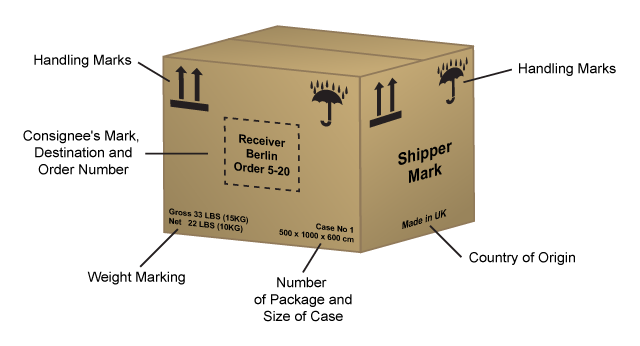In the big business of shipping it is obviously extremely important for those handling cargo to be able to identify what they are dealing with and to take the appropriate measures necessary to ensure safety and ease of transport. In order to make certain that the handlers are able to identify the shipment it is crucial to provide shipping marks which show the handler what type of product is present within the carton or cardboard box used to pack the materials.

Shipping mark guidelines
There are a few key shipping marks related rules that shipping companies need to follow and these include:
- The port and identification marks that indicate destination and transfer points should be applied by stencil with waterproof ink in a large clear font on three sides of the package.
- Coded marks rather than trade names should be present in the shipping mark in order to help ensure that the handlers are less aware of the contents and therefore that the goods are less subject to theft. The codes should be changed from time to time to minimize any familiarity handlers may develop with the codes.
- If the shipment requires any sort of specialist handling or treatment then the shipping marks should indicate it; this information should also be present on the bill of lading.
- All cautionary and handling shipping marks must be permanent and very legible. Ensure that the languages at the origin and destination are the same, and if not make sure that shipping marks are in both languages.
- It is highly recommended that a stencil is used when creating shipping marks as it increases legibility – try to avoid materials which are not waterproof.
Most freight shipping will require a certain level of handling at the target destination and as such it is a good idea to print the handling instructions on the exterior of the shipping crates or cardboard boxes in the language of the destination country.
Pictorial markings
Another potential issue that can become apparent during freight shipping is the fact that the cargo may be handled by those who do not speak either the language of the country of origin or destination. It is also a possibility that the cargo may come into contact with a worker who is illiterate. In order to solve this particular issue, it is prudent to use pictorial markings on the shipping box in order to make sure that no confusion is elicited, and that is the road that big shipping companies such as DHL have gone down. The best thing to do is to procure a copy of the relevant pictorial shipping marks.
When packing material into shipping crates or cartons, make sure that you are noting down the contents of each carton and applying the correct shipping marks to each shipping crate. Have a look at our guide to the various pictorial marks that need to be applied to the correct carton on the basis of its contents.
UN Performance packaging standards for shipping companies
It is imperative that shipping companies do not forget that there are certain UN performance packaging standards that came into effect in January 1991 and that any shipping company wishing to ship potentially hazardous materials should make sure that they are in compliance with the UN standards and also that they are displaying the correct shipping marks in line with the correct freight shipping procedure.
Hazard Classes
1) Explosives – Articles bearing Explosives labels that fall into classes 1.1,1.2,1.3, 1.4F and 1.5 are generally not permitted on air transport
2) Non-flammable, flammable and toxic gases
3) Flammable liquids
4) Flammable solids, substances prone to spontaneous combustion and water reactive substances
5) Oxidising matter and/or organic peroxides
- Poisonous and infectious substances (liquids and solids)
- Radioactive materials
- Corrosive materials including akalines, corrosive solids/liquids and acids
- Other hazardous materials that do not meet the criteria for Classes 1-8 but that are nonetheless still potentially hazardous when transported














